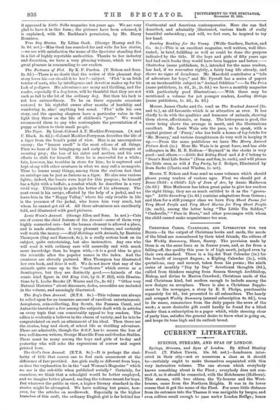CURRENT LITERATITR,E.
SPRINGS, STREAMS, AND SPAS OF LONDON.
Springs, Streams, and Spas of London. By Alfred Stanley Foord. (T. Fisher Unwin. 10s. 6d. net.)—Londoners inter- ested in their city—not so numerous a class as it should be—certainly ought to make themselves acquainted with this very instructive volume. The one stream which everybody knows something about is the Fleet ; everybody does not con- nect it, as it should be connected, with the Holebourne (Holborn). This stream, with two others, the Ty-bourne and the West- bourne, came from the Northern Heights. It was in its lower course that it got the name of the Fleet. For some little distance from its entrance into the Thames it was navigable by barges, and even colliers small enough to pass undcr London Bridge; hence
Seacole Lane and Newcastle Lane. Higher up it was utilised in another way, as Turnmill Lane, on the east side of Farringdon Street, indicates. But there are many other names which, when we consider them for a moment, are as significant as Holborn and Fleet Street. In the City proper there is Wal- brook (connected, it has been suggested, with the word walh, a foreigner, as the vehicle for foreign merchandise). Once this was a fair stream, supplying London within the walls with water, on the banks of which City Companies built their Halls, and which was three hundred feet wide where it flowed into the Thames, and as much as one hundred and twenty at Moor- fields. In Stow's time (1525-1605) it had become something of a nuisance. After rivers come wells. Holywell Street on the north of the Strand would have been ten years ago the most familiar example. This has vanished; Clerkenwell remains, and covers so wide a district that the name is pretty sure to survive. Mr. Foord gives a long list of these springs, most of them supposed to have some curative qualities. A few still exist. Barnet Well, for instance, may yet be seen in Well House Farm near that town. Its waters, once famous—Pepys went there and drank five glasses— cannot now be tasted, for the authorities have neglected to keep the pump in order. Perhaps, in view of what we hear about wells near human dwellings, this is wise. A kindred subject is treated in Part III.,—the water-supply of London. It is a curious fact that new wells are being sunk in the very heart of London. The Water Board bases its demand on the rateable value ; when this is high and the actual use small, as in such a building as the Royal Academy, it is a profitable speculation to sink an artesian well.



































































 Previous page
Previous page